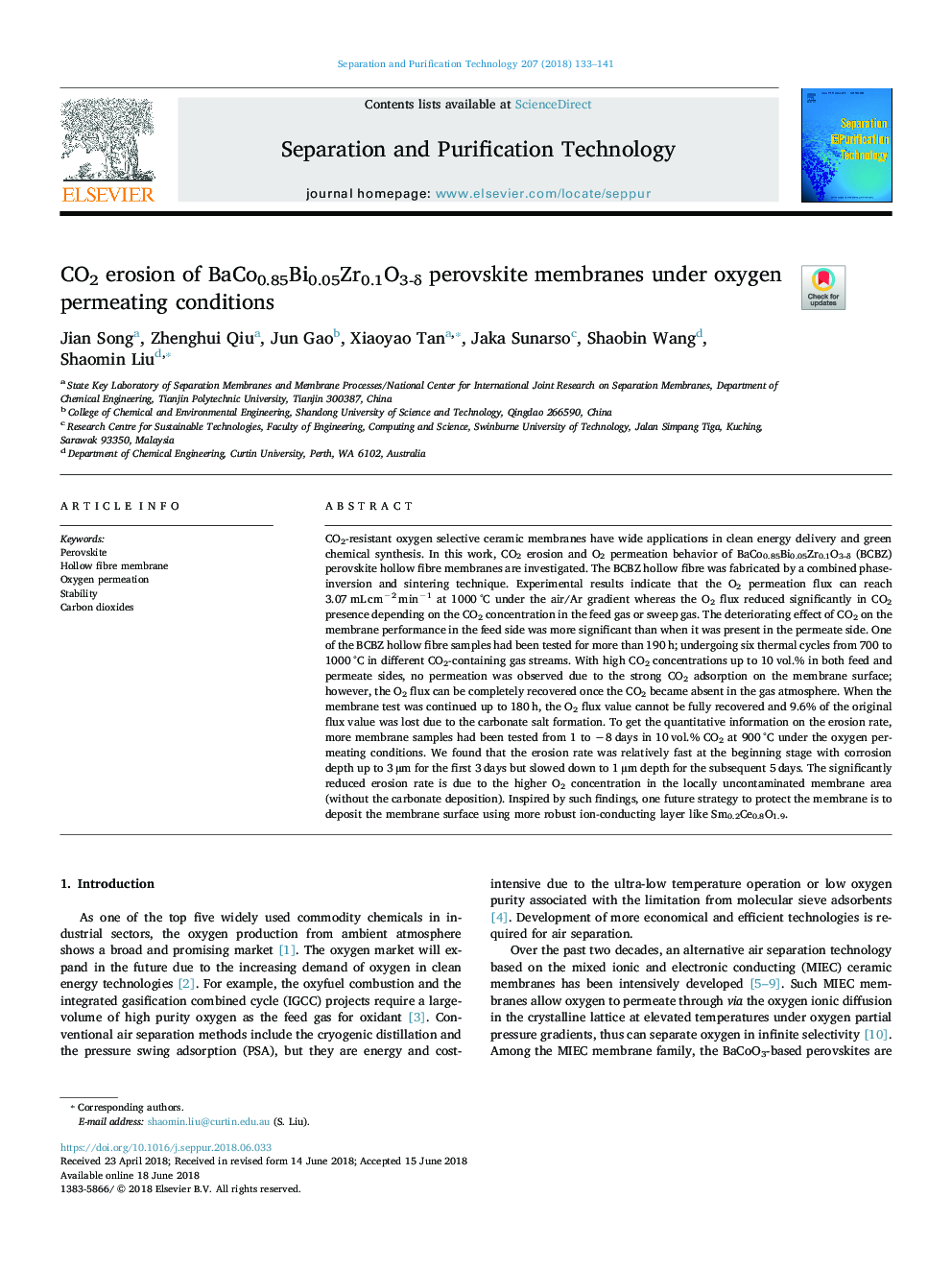| کد مقاله | کد نشریه | سال انتشار | مقاله انگلیسی | نسخه تمام متن |
|---|---|---|---|---|
| 7043525 | 1456913 | 2018 | 9 صفحه PDF | دانلود رایگان |
عنوان انگلیسی مقاله ISI
CO2 erosion of BaCo0.85Bi0.05Zr0.1O3-δ perovskite membranes under oxygen permeating conditions
دانلود مقاله + سفارش ترجمه
دانلود مقاله ISI انگلیسی
رایگان برای ایرانیان
کلمات کلیدی
موضوعات مرتبط
مهندسی و علوم پایه
مهندسی شیمی
تصفیه و جداسازی
پیش نمایش صفحه اول مقاله

چکیده انگلیسی
CO2-resistant oxygen selective ceramic membranes have wide applications in clean energy delivery and green chemical synthesis. In this work, CO2 erosion and O2 permeation behavior of BaCo0.85Bi0.05Zr0.1O3-δ (BCBZ) perovskite hollow fibre membranes are investigated. The BCBZ hollow fibre was fabricated by a combined phase-inversion and sintering technique. Experimental results indicate that the O2 permeation flux can reach 3.07â¯mLâ¯cmâ2â¯minâ1 at 1000â¯Â°C under the air/Ar gradient whereas the O2 flux reduced significantly in CO2 presence depending on the CO2 concentration in the feed gas or sweep gas. The deteriorating effect of CO2 on the membrane performance in the feed side was more significant than when it was present in the permeate side. One of the BCBZ hollow fibre samples had been tested for more than 190â¯h; undergoing six thermal cycles from 700 to 1000â¯Â°C in different CO2-containing gas streams. With high CO2 concentrations up to 10â¯vol.% in both feed and permeate sides, no permeation was observed due to the strong CO2 adsorption on the membrane surface; however, the O2 flux can be completely recovered once the CO2 became absent in the gas atmosphere. When the membrane test was continued up to 180â¯h, the O2 flux value cannot be fully recovered and 9.6% of the original flux value was lost due to the carbonate salt formation. To get the quantitative information on the erosion rate, more membrane samples had been tested from 1 to â8â¯days in 10â¯vol.% CO2 at 900â¯Â°C under the oxygen permeating conditions. We found that the erosion rate was relatively fast at the beginning stage with corrosion depth up to 3â¯Âµm for the first 3â¯days but slowed down to 1â¯Âµm depth for the subsequent 5â¯days. The significantly reduced erosion rate is due to the higher O2 concentration in the locally uncontaminated membrane area (without the carbonate deposition). Inspired by such findings, one future strategy to protect the membrane is to deposit the membrane surface using more robust ion-conducting layer like Sm0.2Ce0.8O1.9.
ناشر
Database: Elsevier - ScienceDirect (ساینس دایرکت)
Journal: Separation and Purification Technology - Volume 207, 22 December 2018, Pages 133-141
Journal: Separation and Purification Technology - Volume 207, 22 December 2018, Pages 133-141
نویسندگان
Jian Song, Zhenghui Qiu, Jun Gao, Xiaoyao Tan, Jaka Sunarso, Shaobin Wang, Shaomin Liu,